Related Research Articles
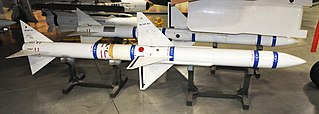
The AIM-7 Sparrow is an American medium-range semi-active radar homing air-to-air missile operated by the United States Air Force, United States Navy, United States Marine Corps, and various other air forces and navies. Sparrow and its derivatives were the West's principal beyond visual range (BVR) air-to-air missile from the late 1950s until the 1990s. It remains in service, although it is being phased out in aviation applications in favor of the more advanced AIM-120 AMRAAM.

The Avro Canada CF-105 Arrow was a delta-winged interceptor aircraft designed and built by Avro Canada. The CF-105 held the promise of Mach 2 speeds at altitudes exceeding 50,000 feet (15,000 m) and was intended to serve as the Royal Canadian Air Force's (RCAF) primary interceptor into the 1960s and beyond.
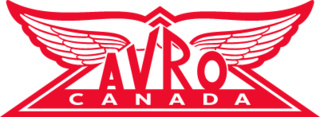
Avro Canada was a Canadian aircraft manufacturing company. It was founded in 1945 as an aircraft plant and within 13 years became the third-largest company in Canada, one of the largest 100 companies in the world, and directly employing over 50,000. Avro Canada was best known for the CF-105 Arrow, but through growth and acquisition, it rapidly became a major, integrated company that had diverse holdings.

Gerald Vincent Bull was a Canadian engineer who developed long-range artillery. He moved from project to project in his quest to economically launch a satellite using a huge artillery piece, to which end he designed the Project Babylon "supergun" for Saddam Hussein's government in Iraq.
DRDC Valcartier is a major Canadian military research station at Canadian Forces Base Valcartier, Quebec, one of nine centres making up Defence Research and Development Canada (DRDC).

The Avro Canada CF-100 Canuck is a Canadian twinjet interceptor/fighter designed and produced by aircraft manufacturer Avro Canada. It has the distinction of being the only Canadian-designed fighter to enter mass production.

The RIM-162 Evolved SeaSparrow Missile (ESSM) is a development of the RIM-7 Sea Sparrow missile used to protect ships from attacking missiles and aircraft. ESSM is designed to counter supersonic maneuvering anti-ship missiles. ESSM also has the ability to be "quad-packed" in the Mark 41 Vertical Launch System, allowing up to four ESSMs to be carried in a single cell.

The Hughes AIM-4 Falcon was the first operational guided air-to-air missile of the United States Air Force. Development began in 1946; the weapon was first tested in 1949. The missile entered service with the USAF in 1956.

The McDonnell CF-101 Voodoo was an all-weather interceptor aircraft operated by the Royal Canadian Air Force and the Canadian Forces between 1961 and 1984. They were manufactured by the McDonnell Aircraft Corporation of St. Louis, Missouri for the United States Air Force, and later sold to Canada. CF-101s replaced the obsolete Avro CF-100 Canuck in the RCAF's all-weather fighter squadrons. The Voodoo's primary armament was nuclear AIR-2A Genie unguided air-to-air rockets, and there was significant political controversy in Canada about their adoption. Although they never fired a weapon in wartime, the CF-101 served as Canada's primary means of air defence from Quick Reaction Alert facilities at Canadian airbases. The CF-101s were retired in the 1980s and replaced with McDonnell Douglas CF-18 Hornet fighters. Many examples are preserved in museums and parks in Canada and the United States.

The Canadair CP-107 Argus is a maritime patrol aircraft designed and manufactured by Canadair for the Royal Canadian Air Force (RCAF). The Argus served throughout the Cold War in the RCAF's Maritime Air Command and later the Canadian Force's Maritime Air Group and Air Command.

The Canadair Sabre is a jet fighter aircraft built by Canadair under licence from North American Aviation. A variant of the North American F-86 Sabre, it was produced until 1958 and used primarily by the Royal Canadian Air Force (RCAF) until replaced with the Canadair CF-104 in 1962. Several other air forces also operated the aircraft.

The Canadair CF-104 Starfighter is a modified version of the Lockheed F-104 Starfighter supersonic fighter aircraft built in Canada by Canadair under licence. It was primarily used as a ground attack aircraft, despite being designed as an interceptor. It served with the Royal Canadian Air Force (RCAF) and later the Canadian Armed Forces (CAF) until it was replaced by the McDonnell Douglas CF-18 Hornet in 1987.
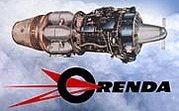
Orenda Engines was a Canadian aircraft engine manufacturer and parts supplier. As part of the earlier Avro Canada conglomerate, which became Hawker Siddeley Canada, they produced a number of military jet engines from the 1950s through the 1970s, and were Canada's primary engine supplier and repair company.
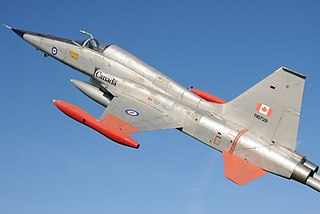
The Canadair CF-5 is a Canadian licensed-built Northrop F-5 Freedom Fighter. It is a light, supersonic, twin engine, daylight air superiority fighter primarily for the Canadian Forces and the Royal Netherlands Air Force. The CF-5 was upgraded periodically throughout its service life in Canada. While Canadian Forces retired the aircraft in 1995, it continues to be used by other countries.
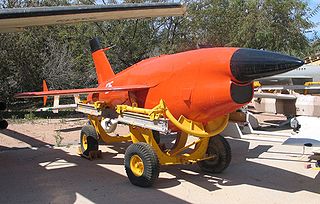
The Ryan Firebee is a series of target drones developed by the Ryan Aeronautical Company beginning in 1951. It was one of the first jet-propelled drones, and remains one of the most widely used target drones ever built.

434 Operational Test and Evaluation Squadron is a Royal Canadian Air Force bomber squadron that flew bombing operations over Europe during World War II and was later a post-war fighter and combat support unit. It was disbanded in 2000. The squadron was reactivated in May 2018 as 434 Operational Test and Evaluation.
Canadian Forces Base Picton was a military installation located in Picton, Ontario. The base was active from the Second World War to 1969 and served the Royal Air Force, Royal Canadian Air Force and Canadian Army. Today, the site functions as the Picton Airport.

The Avro Canada TR5 Orenda was the first production jet engine from Avro Canada's Gas Turbine Division. Similar to other early jet engines in design, like the Rolls-Royce Avon or General Electric J47.

The National Air Force Museum of Canada is an aviation museum dedicated to preserving the history of the Royal Canadian Air Force (RCAF) and is located on the west side of CFB Trenton in Trenton, Ontario.

The Avro Canada CF-103 was a proposed Canadian interceptor, designed by Avro Canada in the early 1950s as a development, and possible replacement of the company's CF-100 Canuck, that was entering service at the time with the Royal Canadian Air Force (RCAF). Although intended to be capable of flying at transonic speeds, the CF-103 only offered a moderate increase in performance and capability over the CF-100; subsequently, the aircraft never progressed beyond the mock-up stage.
References
Notes
Bibliography
- Beadle, Peter (1998). "Picton Test Range". Archived from the original on 30 August 2009. Retrieved 27 June 2009.
- Chauhan, Sharad (2003). War on Iraq. APH Publishing.
- "Commonwealth Aviation: The Canadian Industry". Flight. August 1956. p. 298. Archived from the original on 16 October 2012. Retrieved 27 June 2009.
- McLin, Jon (1967). Canada's changing defense policy, 1957–1963. Johns Hopkins Press. pp. 65–66.
- Ordway, Frederick & Wakeford, Ronald (1960). International Missile and Spacecraft Guide. McGraw-Hill.